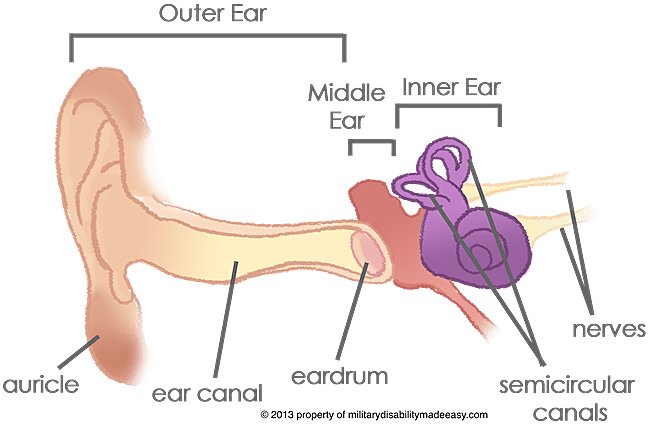The Ears
Topics:
The Ears Overview
Disability Ratings for Conditions of the Ears
The Ears Overview
The VA awards disability compensation for each condition of the Ears that is service-connected. The DoD will also rate service-connected conditions as long as they also make the service member Unfit for Duty. For Reservists, the condition must have occurred in or resulted from an injury in the Line of Duty to qualify.
The Ear is a unique sensory organ. While the main function of the Ear is to control hearing, it also controls the body’s balance. Because of this, the VA focuses the disability rating system for conditions of the Ears primarily on hearing loss, with additional rating options to cover conditions affecting balance, infections, etc.
To honor the Pyramiding Principle, only a single rating can be given for multiple Ear conditions that affect hearing. If the Ear conditions, however, cause distinctly different symptoms, then those symptoms can be rated in addition to a rating for hearing loss. For example, if an Ear condition or conditions cause hearing loss, tinnitus, and dizziness, then each distinct symptom can be rated separately under their appropriate codes (see The Ear Ratings page).

Return to Top
Disability Ratings for Conditions of the Ears
The VASRD offers ratings for the following conditions of the Ears:
- Hearing Loss
- Otosclerosis
- Auricle Loss
- Eardrum Injuries
- Tinnitus
- Otitis (Earaches)
- Cholesteatoma
- Balance Disorders
- Cancer and Tumors of the Ear
If an Ear condition is not directly listed, it is rated under the code that best describes it or its dominant symptom.
In addition to or instead of the standard disability compensation for Ear conditions, the complete loss of hearing in both Ears or a single Ear when combined with other disabilities may also qualify for Special Monthly Compensation.
Return to Top
FAQs
How will the VA rate my Ear condition for disability?
The VA uses the rules of the VASRD to rate Ear conditions based on the symptoms that they cause. Check out our Ear Ratings page for the exact codes and ratings.
What will my hearing loss be rated for VA disability?
The VA can only rate conditions that meet some type of service-connection requirement. If your Ear condition is the result of another service-connected condition or if you have hearing loss or tinnitus and your MOS is on the Noise Exposure Listing with the evidence required, it will qualify.
What is the Noise Exposure Listing?
The Noise Exposure Listing is a list of MOS's in each branch that ranks each MOS on the likelihood of noise exposure. It is used to prove service-connection for hearing loss and/or tinnitus that is diagnosed after service.
How do I apply to receive my ratings for my Ear conditions?
If you are still in the military, then you can request your military physician to refer you to the MEB and start the IDES process. If you are already a veteran, you can submit a VA Disability Claim along with evidence of service-connection and all medical records regarding the conditions on the claim.
If my claim is approved, what benefits will I receive?
If you are rated 20% or less from the DoD, then you will receive a single separation payment. If you are rated 30% or more, you will receive full retirement benefits. From the VA, you will receive a monthly payment as well as full medical care from the VA for the qualifying conditions.
How long does it take to receive my disability benefits?
Brand new claims usually take 3-6 months to process. Once processed, you will start receiving payments in 1-3 months.
How are the rating percentages assigned to my conditions?
The rules of the VA's Schedule for Rating Disabilities (VASRD) are used to assign rating percentages to conditions. The VASRD gives rating rules for conditions based on their symptoms, treatment options, and the resulting level of disability they cause.
My conditions have worsened. How do I increase my rating percentages?
If your conditions have worsened since you last applied and now qualify for a higher rating, you can submit a new claim, checking the box for an increased evaluation.



